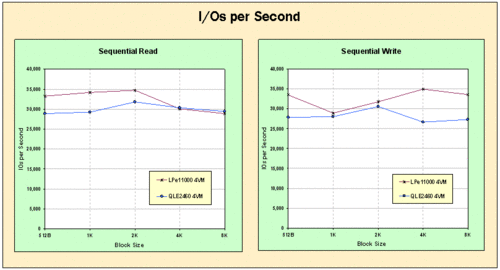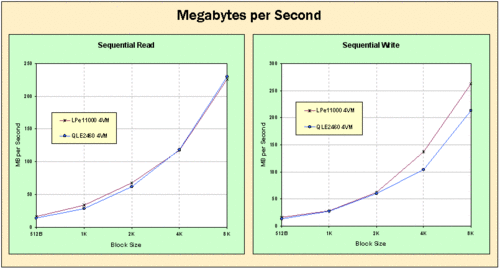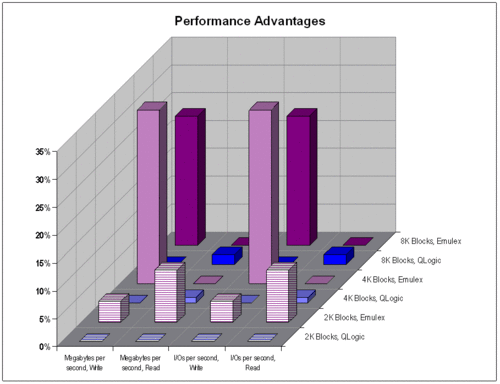Contents |
Introduction
Emulex Corporation commissioned Demartek to evaluate the performance of Emulex Host Bus Adapters (HBAs) in the VMware ESX Server environment, and compare this performance to the equivalent QLogic® HBA. Storage performance characteristics and implementation details are different when running in virtual environments such as VMware with guest operating systems as compared to running a native operating system on a server. Emulex sought an independent view of its Fibre Channel HBA performance in a VMware environment.
Technical Focus of This Paper
The tests run for this paper used four VM instances running in the VMware environment.
Although we used a wide range of block sizes in the I/O tests, ranging from 512 bytes to 1 megabyte, some block sizes are of particular interest. Popular applications use some of these particular block sizes, which are shown below:
Oracle databases are typically configured to use 4K and 8K block sizes, but can also be configured to use 16K block sizes.
Evaluation Summary
Demartek’s general findings were that the Emulex HBA outperformed the QLogic HBA in 2K, 4K and 8K block sizes with four virtual machines running in the VMware environment. The Emulex HBA was up to 9% faster in read I/O per second, 31% faster in write I/O per second and 31% faster in total throughput at these block sizes. These block sizes in particular are used by Microsoft Exchange Server, Microsoft SQL Server and Oracle databases.
Test Results
A series of identical IOMeter tests were run in the VMware environment with four virtual machines. These tests spanned a wide range of block sizes, from 512 bytes to 1 Megabyte, and included sequential reads and sequential writes. IOMeter tests were run for each HBA and each VM configuration, resulting in four sets of results for reads and writes. Several characteristics were measured, including I/Os per second (IOPS) and Megabytes per second. The results of the 4-VM runs for block sizes up to 8K are shown in the body of this report.
IOPS
The Emulex HBA generally performed better than the QLogic HBA in IOPS at the 2K, 4K and 8K block sizes. Applications such as Microsoft Exchange Server, Microsoft SQL Server and Oracle benefit by increased performance in these block sizes.
Megabytes per Second
At the 2K, 4K and 8K block sizes, the Emulex HBA was equal to or slightly outperformed the QLogic HBA for both reads and writes.
IOMeter Configuration
For each virtual machine environment, IOMeter was run with the same parameters, and in the case of four virtual machines, IOMeter executed on all four machines at the same time. The IOMeter settings included I/O to eight disks (virtual disks in the RAMSAN unit) and a queue depth (outstanding I/Os) of eight. For the four-VM environment, there were two workers in each of the four environments for a total of eight I/O workers, each writing to one 1GB RAMSAN disk.
All the reads and writes were 100% sequential. IOMeter script files were used to test each of the data block size options. Each block size test ran for 15 seconds. Because the target was a RAM-based storage device, random and sequential I/O are expected to take the same amount of time.
Summary and Conclusion
For the block sizes up through 8K, the Emulex HBA performed better than the QLogic HBA in terms of raw speed. These block sizes are common for many applications. In particular, the 4K and 8K block sizes are used by applications such as Microsoft Exchange, Microsoft SQL Server, and the Oracle databases.
The table and graph below summarize the performance differences between the Emulex HBA and the QLogic HBA in the VMware environment.
Appendix A – Evaluation Environment
This evaluation was conducted at the Emulex facilities, using an HP DL380 G5 server running VMware ESX 3.0.1 with Windows 2003 Server as virtual machine operating systems. The HP DL380 G5 used for these tests includes a dual-core 2.33 GHz processor with 2 GB RAM, connected to a Brocade 4100 Silkworm Fibre Channel Switch and two Texas Memory Systems RAMSAN 400 storage units with eight 4Gbs Fibre Channel ports. Each port was mapped to a dedicated 1GB RAMSAN LUN. The Texas Memory Systems RAMSAN was chosen because of its use of memory as a storage device minimizes latency and I/O response time and eliminates the storage device as a potential bottleneck.
The tests were run with four virtual machines running I/O concurrently. Each virtual machine was configured with one CPU and 256MB of RAM memory. Each virtual machine was configured with 2 1GB virtual disks using RDM to which the performance tests were run.
HBAs used for these tests included Emulex LPe11000 and QLogic QLE2460. Both of these models are single-port, 4 Gbs, PCI-Express x4 Fibre Channel host bus adapters.
The tests were run using IOMeter, an industry standard, open source I/O load generator, available from Source Forge at http://sourceforge.net/projects/iometer/.
Action Item:
Footnotes: Reprinted with permission © 2008 Demartek
See the full article at Demartek
Evaluation report prepared under contract with Emulex Corporation
Emulex is a registered trademark of Emulex Corporation.
QLogic is a registered trademark of QLogic Corporation.
VMware is a registered trademark of VMware, Inc.
All other trademarks are the property of their respective owners.







